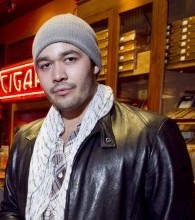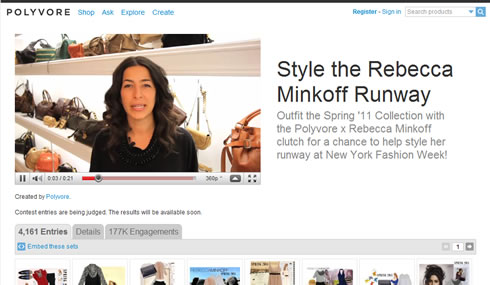A Chat With Daniel Saynt, Chief Marketing Officer at Rebecca Minkoff
We keep hearing that fashion bloggers are the future of the industry. While the front row at fashion shows has become a bit more diversified in recent years, blogger relations for fashion brands often follows a certain formula:
1. Place recognizable street or personal style bloggers next to recognizable fashion editors, let debate over the death of print ensue (while continuing to spend hundreds of thousands of dollars on print advertising)
2. Place recognizable street or personal style blogger in print campaign
3. Collaborate with recognizable street or personal style blogger on a one time product or campaign
All of which are a great acknowledgment of the growing influence of fashion bloggers, but also fleeting. Vogue gets to be Vogue because they know that month after month, certain brands will support them. September may be the month when everyone buys an ad, but come June or July (off season for fashion media), ad pages haven’t totally disappeared. For a few weeks in February and September, and the run up to Christmas, you’re likely to see bloggers everywhere – in print campaigns, competitions, online collaborations and behind limited edition products. Unlike magazines, however, once the off season rolls in, the campaigns and collaborations roll away.
 That makes Daniel Saynt’s new job as Chief Marketing Officer at independent fashion label Rebecca Minkoff noteworthy. Saynt previously ran Fashion Indie (one of the 99 most influential fashion blogs), and a network of related sites including TheyEnvy.us and SIFJ.org, which he sold to Lookbooks.com for $300,000 last year. While Saynt’s experience as a blogger played a role in his selection for the job, a long term hire and year round responsibilities are well outside the standard invite, expose, collaborate model that most companies take. We asked the notoriously outspoken new hire about his plans for the brand, the future of blogging beyond the formula, and online priorities.
That makes Daniel Saynt’s new job as Chief Marketing Officer at independent fashion label Rebecca Minkoff noteworthy. Saynt previously ran Fashion Indie (one of the 99 most influential fashion blogs), and a network of related sites including TheyEnvy.us and SIFJ.org, which he sold to Lookbooks.com for $300,000 last year. While Saynt’s experience as a blogger played a role in his selection for the job, a long term hire and year round responsibilities are well outside the standard invite, expose, collaborate model that most companies take. We asked the notoriously outspoken new hire about his plans for the brand, the future of blogging beyond the formula, and online priorities.
S9: For bloggers who function more as editors or writers, do you think we’ll see more brands looking to blogrolls for long term hires and the people who coordinate campaigns?
Saynt:Â Yes. Yes I Do.
Bloggers are the next generation of fashion. We are growing in revenue and gaining more experience. We’re connected to the industry and anyone above the age of 30 listens to us because they have no fucking clue what they are doing online.
Fashion bloggers are collectively more powerful than the Vogues of the world. The revolution has begun.
S9: We always hear brands paying lip service to the importance of social media and online promotion, but when it comes to marketing dollars the majority still go towards magazine ads and PR to reach print journalists and editors. Given that you’re leading all marketing for Rebecca Minkoff now, what’s your perspective on striking the right balance?
Saynt: Simply put, we’re focusing the bulk of our marketing attention online. The partnerships we’re establishing will lead most of our market influence over the next year. It’s going to be a very exciting!
S9: What level of importance would you place on magazines and print publications? Currently, and say 5 years out.
Saynt: Magazines will evolve. I’m currently working with Lucky Magazine on their FABB Conference and blogger focused initiatives. In March, I’m beginning a project with Don Hellinger, the wildly intelligent publisher of Nylon, Surface, Factory and Inked Magazine. Next week I’m sitting with Zink Magazine to assist with their desire to increase their attention on the web and I’m planning on a project that will connect me to Daniel Nardicio [of Playgirl].
S9: You come from a background of building an audience for your own websites. How does that affect your planning as compared to someone coming from an agency or more traditional fashion marketing background?
Saynt: Most brands succeed at building an audience by pumping millions into advertising. I built my audience with nothing. Knowing how to do that is more important then being from an agency that can only get messages out to a small few, and only when they have money to spend.
Now that I have a budget, I’m combining that with my ability to negotiate and get things done for cheap or free. Rebecca Minkoff will succeed in ways that have yet to succeed.
S9: Rebecca Minkoff recently finished a styling competition on Polyvore, and had another design focused competition that garnered a lot of reactions. Are there any other fashion startups or communities that you’re excited about?
Saynt: Bloglovin.com, Lookbook.nu, Tumblr.com, Bambuser.com, [mobile scavenger hunt app] GoldRun and a few others we’re exploring like FashionStake.com.
We’re building our relationships with Refinery29.com, DailyCandy.com, Shopbop.com, Ideeli.com, Gilt.com, Hautelook.com, Shopify.com, StumbleUpon.com, RenttheRunway.com, Yoox.com, TheOutnet.com among others.
And right now I’m working on a strategic partnership with Google, Bing, Twitter, Facebook and Netaporter.com.
So basically, everyone that matters.
S9: Facebook, Twitter, Tumblr aren’t specific to fashion, but Facebook is too big to ignore for almost anyone, and the others have attracted attention from a lot of fashion brands. Each one requires a somewhat different strategy though. How would you rank each platform in terms of priority, and why?
Saynt: Priority really comes down to which engages with fashion most. Tumblr is focused on our world now, scooping up Rich Tong of Weardrobe.com,  so my current priority is [Tumblr]. Still, Twitter and Facebook are considered high priority as well.

